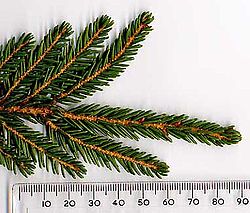- Picea orientalis
-
Picea orientalis Foliage Conservation status Scientific classification Kingdom: Plantae Division: Pinophyta Class: Pinopsida Order: Pinales Family: Pinaceae Genus: Picea Species: P. orientalis Binomial name Picea orientalis
(L.) LinkPicea orientalis, commonly known as the Caucasian Spruce or Oriental Spruce, is a spruce native to the Caucasus and adjacent northeast Turkey. It is a large evergreen tree growing to 30–45 m tall (exceptionally to 57 m), and with a trunk diameter of up to 1.5 m (exceptionally up to 4 m).
The shoots are buff-brown, and moderately pubescent (hairy). The leaves are needle-like, the shortest of any spruce, 6-8 mm long, rhombic in cross-section, dark green with inconspicuous stomatal lines. The cones are slender cylindric-conic, 5-9 cm long and 1.5 cm broad, red to purple when young, maturing dark brown 5–7 months after pollination, and have stiff, smoothly rounded scales.
Caucasian Spruce is a popular ornamental tree in large gardens, valued in northern Europe and the USA for its attractive foliage and ability to grow on a wide range of soils. It is also grown to a small extent in forestry for Christmas trees, timber and paper production, though its slower growth compared to Norway Spruce reduces its importance outside of its native range.
References
- ^ Conifer Specialist Group (1998). Picea orientalis. 2006. IUCN Red List of Threatened Species. IUCN 2006. www.iucnredlist.org. Retrieved on 12 May 2006.
External links
 Media related to Picea orientalis at Wikimedia Commons
Media related to Picea orientalis at Wikimedia Commons  Data related to Picea orientalis at WikispeciesCategories:
Data related to Picea orientalis at WikispeciesCategories:- IUCN Red List least concern species
- Picea
- Plants described in 1847
- Trees of Turkey
- Ornamental trees
- Least concern plants
Wikimedia Foundation. 2010.



